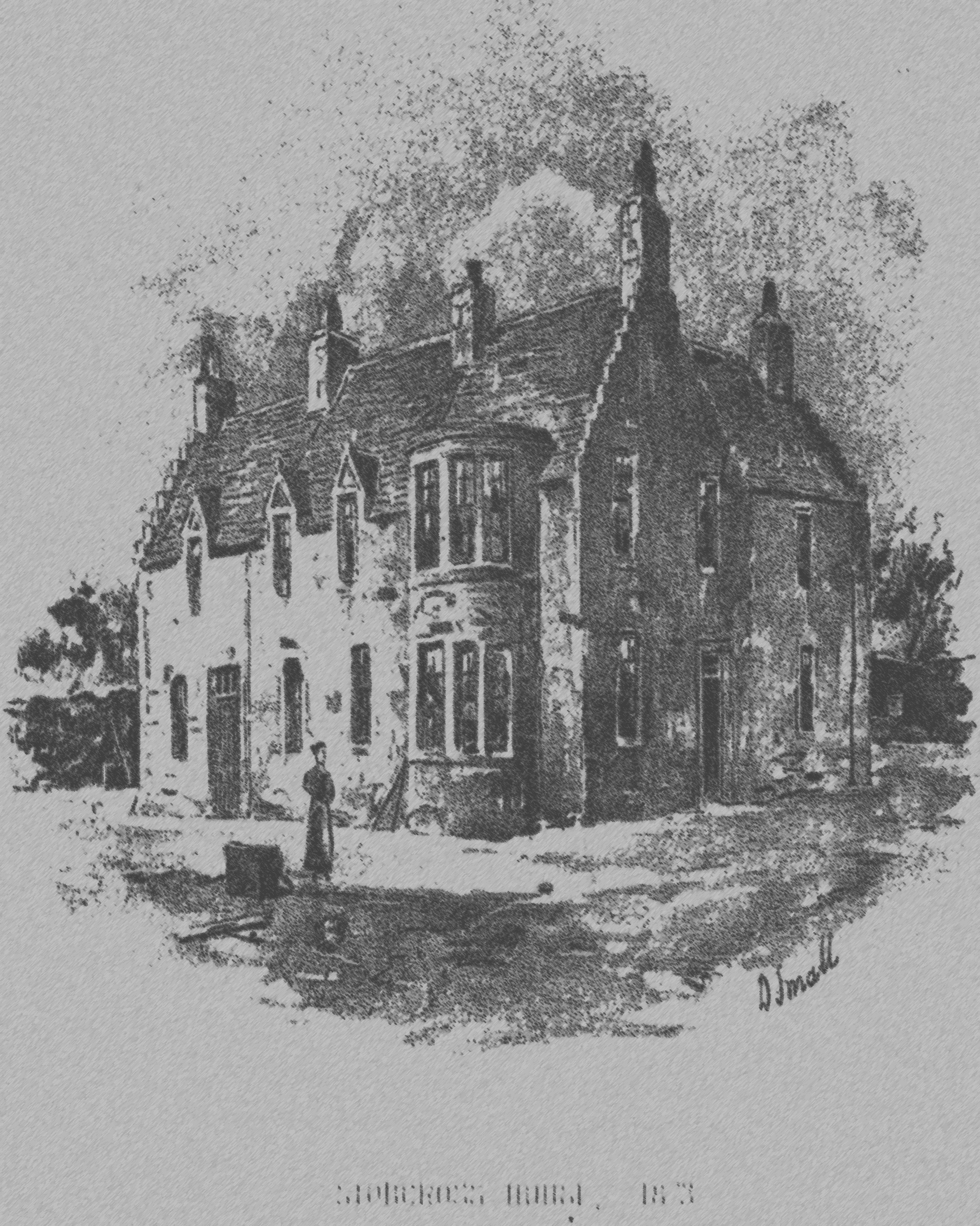
STOBCROSS HOUSE

One of the most interesting estates in the neighbourhood of Glasgow was that of Stobcross, yet its story has never been written ; and beyond the slight outline of its early history given in the "Old Country Houses of the Old Glasgow Gentry", no attempt has been made to preserve any notes regarding the place. The following brief sketch is founded upon documents not hitherto utilised in this connection, and may be useful as relating to a property that displays the advance of Glasgow in a very notable manner.
The name of "Stob-corss" plainly indicates an ecclesiastical origin. There can be little doubt that it is derived from a wooden wayside cross set up near the spot where the by-road led to the Clyde from the main highway to the Bishop's Castle at Partick. Like Over Newton the lands of Stobcross were included in the grant of Partick to the Cathedral by David I in 1136. Consequently, these lands appear in various early charters, and in the rental-books of the Diocese. And it is interesting to find that for centuries the estate of Stobcross was continuously in the possession of the family of Anderson, who gave their name to Anderston, and supplied "that notable Provost" Anderson of Dowhill to the city of Glasgow. About the beginning of the sixteenth century Andrew Anderson was "rentaller" in Stobcross, holding his feu from the Archbishop of Glasgow. He had one son, James, who succeeded him ; and, in 1547, Ninian, son of James, obtained a feu in Capok with consent of his three aunts, Janet, Bessy, and Violet Anderson. In 1555 James Anderson and his wife Janet Maxwell resigned Stobcross to their son John, retaining their life-rent in the property. In 1563 John Anderson died, and his son William succeeded to Stobcross, subject to the life-rent of "Jonet Maxwel, his gudame", who was still alive. From a charter by Archibald Douglas, the infamous "Parson of Glasgow" who was concerned in Rizzio's murder, it appears that in 1579 John Anderson had been proprietor of Stobcross, and of "the Personis-haugh, alias Rankynnis-haugh", which was adjacent to Cranstonhill. When the regality of Glasgow, which had formerly belonged to the Archbishops, was conferred upon Walter Stewart, Commendator of Blantyre, in 1587, the charter mentioned the contiguous lands of "Stobcors, Over and Nethir Newtoun, the west syde of Partik, the eist syde of Partik, Hindland, etc.", though the names of the proprietors were not given. But in a charter, dated 15th January 1590-91, the name of John Anderson appears as former laird of Stobcross. William Anderson was proprietor in 1611, and was probably the heir who succeeded in 1563. His grandson, James Anderson, who was laird of Stobcross in the latter half of the seventeenth century, was the first of the family that turned the estate to practical account. He feued out that portion of the lands at the extreme eastern boundary, which included the old farm of Gushet, and projected the village of Anderston, which was named after himself. In his plan he proposed to feu the old ecclesiastical lands of "Parson's-haugh", also called "Rankine's-haugh", which lay between Gushet and Cranstonhill. The following description of Stobcross House in James Anderson's time was written by Hamilton of Wishaw in 1696 : "James Anderson of Stobcorse heth there a convenient house, sited upon ane eminence above the rivir, with suitable gardens, and avenue to the Avater". This avenue followed the course of the present Finnieston Street ; but the main avenue to the house from the east was afterwards transformed into Stobcross Street.
John Orr, who acquired the estate from James Anderson in 1745, made many alterations upon the old mansion. He conveyed the property to his nephew, Matthew Orr, in 1751, and the document by which this conveyance was effected refers to the manor-place and the dove-cot, the latter of which was a strongly-built tower, east from the mansion, which was removed when Elliot Street was opened about forty years ago. Cranstonhill was feued off the estate by John Orr to William Baird, maltman, and by the Bairds and their successors the Houldsworths, the streets that now form this populous district were devised and opened. Matthew Orr, with greater wisdom than his uncle, determined to keep the feuing of the rest of Stobcross in his own hands. He laid out 20 acres of the estate for building, forming a plan for wide streets in 1768, and naming the new suburb "Finnieston", after the Rev. John Finnie, who had been his tutor, and was then factor on Barrowfield, the estate that belonged to Mr Orr's father. Finnieston House was erected in 1770 on the west side of the avenue now called Finnieston Street. In 1776 Matthew Orr sold all the lands of Stobcross west of Finnieston to David Watson, banker, Glasgow. Orr ventured into several commercial speculations with his brother, John Orr of Barrowfield, but these were unsuccessful ; and he went to the West Indies, and died at Tobago in 1790, David Watson was laird of Stobcross till his death in 1783, leaving six of a family, all in minority, and his trustees unwisely sold Stobcross, with the mansion, to John Phillips, merchant, Glasgow, who resided in the house, and died there in 1829. One of his daughters, Mrs Rowan, lived in Stobcross House till 1844; but at that date the trustees on Phillips's estate sold the property to a syndicate of Glasgow citizens, by whom the whole of the ground was laid out for building, save 20 acres that were purchased by the Clyde Trustees for the formation of Queen's Dock.
from "By-gone Glasgow" by David Small, 1896